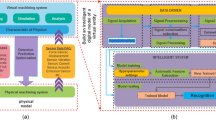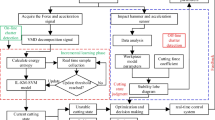Abstract
Smart machining is becoming a major trend in the present manufacturing industry, which is increasingly adopting digital technology and artificial intelligence to improve production processes’ quality, speed, efficiency, and safety. This condition leads to the presentation of an updated study regarding the application of the digital-twin virtual machining model development, to detect chatter phenomena in milling processes. Chatter is a dynamic interaction where an instability state is observed between the workpiece and the cutter during material removal. This process affects the roughness of the finish surface and tool-life and eventually reduces the machining results in quality. Consequently, a novel intelligent machining system was developed for detecting chatter based on the variational mode decomposition method, wavelet-based synchro-squeeze transform, and Transfer Learning (TL) application. This TL application was created using modified pre-trained convolution neural networks to identify unstable (chatter) or stable state conditions of the process of milling-cut. The model was also developed due to being data-driven, where the measured vibration signals for the process of milling-cut were trained and tested through several modified pre-trained networks. The results showed a good-level model with an average classification accuracy of 94.04%. Therefore, the manufacturing industry could adopt this novel method, especially in machining, to overcome the problem of emphasizing the limited process of data monitoring conditions.

























Similar content being viewed by others
Data availability
The authors declare that all data’s presented in this article are available.
Code availability
The authors state that no codes are provided in this publication.
References
Afazov, S., & Scrimieri, D. (2020). Chatter model for enabling a digital twin in machining. The International Journal of Advanced Manufacturing Technology, 110, 2439–2444. https://doi.org/10.1007/s00170-020-06028-9
Ali, J. B., Saidi, L., Harrath, S., Bechhoefer, E., & Benbouzid, M. (2018). Online automatic diagnosis of wind turbine bearings progressive degradations under real experimental conditions based on unsupervised machine learning. Applied Acoustics, 132, 167–181. https://doi.org/10.1016/j.apacoust.2017.11.021
Altintaş, Y., & Budak, E. (1995). Analytical prediction of stability lobes in milling. CIRP Annals, 44(1), 357–362. https://doi.org/10.1016/S0007-8506(07)62342-7
Armendia, M., Cugnon, F., Berglind, L., Ozturk, E., Gil, G., & Selmi, J. (2019). Evaluation of machine tool digital twin for machining operations in industrial environment. Procedia CIRP, 82, 231–236. https://doi.org/10.1016/j.procir.2019.04.040
Azka, M., Yamada, K., Huda, M. A., Tanaka, R., & Sekiya, K. (2020). Influence of tool posture and position on stability in milling with parallel kinematic machine tool. International Journal of Precision Engineering and Manufacturing, 21, 2359–2373. https://doi.org/10.1007/s12541-020-00416-7
Benbouzid, M. (2021). Signal processing for fault detection and diagnosis in electric machines and systems. Institution of Engineering & Technology. https://doi.org/10.1049/PBPO153E
Berger, B. S., Minis, I., Harley, J., Rokni, M., & Papadopoulos, M. (1998). Wavelet based cutting state identification. Journal of Sound and Vibration, 213(5), 813–827. https://doi.org/10.1006/jsvi.1997.1495
Bi, Z., Zhang, C. W., Wu, C., & Li, L. (2022). New digital triad (DT-II) concept for lifecycle information integration of sustainable manufacturing systems. Journal of Industrial Information Integration, 26, 100316.
Carmona, R. A., Hwang, W. L., & Torrésani, B. (1997). Characterization of signals by the ridges of their wavelet transforms. IEEE Transactions on Signal Processing, 45(10), 2586–2590. https://doi.org/10.1109/78.640725
Chen, X., Yang, Y., Cui, Z., & Shen, J. (2019). Vibration fault diagnosis of wind turbines based on variational mode decomposition and energy entropy. Energy, 174, 1100–1109. https://doi.org/10.1016/j.energy.2019.03.057
Daubechies, I., Lu, J., & Wu, H. T. (2011). Synchro-squeezed wavelet transforms: An empirical mode decomposition-like tool. Applied and Computational Harmonic Analysis, 30(2), 243–261. https://doi.org/10.1016/j.acha.2010.08.002
Daubechies, I., & Maes, S. (2017). A nonlinear squeezing of the continuous wavelet transform based on auditory nerve models. Wavelets in medicine and biology (pp. 527–546). Routledge.
Dibaj, A., Ettefagh, M. M., Hassannejad, R., & Ehghaghi, M. B. (2021). A hybrid fine-tuned VMD and CNN scheme for untrained compound fault diagnosis of rotating machinery with unequal-severity faults. Expert Systems with Applications, 167, 114094. https://doi.org/10.1016/j.eswa.2020.114094
Ding, Y., Zhu, L., Zhang, X., & Ding, H. (2010). A full-discretization method for prediction of milling stability. International Journal of Machine Tools and Manufacture, 50(5), 502–509. https://doi.org/10.1016/j.ijmachtools.2010.01.003
Dragomiretskiy, K., & Zosso, D. (2013). Variational mode decomposition. IEEE Transactions on Signal Processing, 62(3), 531–544. https://doi.org/10.1109/TSP.2013.2288675
Elbestawi, M. A., Papazafiriou, T. A., & Du, R. X. (1991). In-process monitoring of tool wear in milling using cutting force signature. International Journal of Machine Tools and Manufacture, 31(1), 55–73. https://doi.org/10.1016/0890-6955(91)90051-4
Feng, J., Sun, Z., Jiang, Z., & Yang, L. (2016). Identification of chatter in milling of Ti-6Al-4V titanium alloy thin-walled workpieces based on cutting force signals and surface topography. The International Journal of Advanced Manufacturing Technology, 82, 1909–1920. https://doi.org/10.1007/s00170-015-7509-0
Gu, R., Chen, J., Hong, R., Wang, H., & Wu, W. (2020). Incipient fault diagnosis of rolling bearings based on adaptive variational mode decomposition and Teager energy operator. Measurement, 149, 106941. https://doi.org/10.1016/j.measurement.2019.106941
Guo, M., Fang, X., Hu, Z., & Li, Q. (2023). Design and research of digital twin machine tool simulation and monitoring system. The International Journal of Advanced Manufacturing Technology, 124(11–12), 4253–4268. https://doi.org/10.1007/s00170-022-09613-2
Huang, P., Li, J., Sun, J., & Zhou, J. (2013). Vibration analysis in milling titanium alloy based on signal processing of cutting force. The International Journal of Advanced Manufacturing Technology, 64, 613–621. https://doi.org/10.1007/s00170-012-4039-x
Iandola, F. N., Han, S., Moskewicz, M. W., Ashraf, K., Dally, W. J., & Keutzer, K. (2016). SqueezeNet: AlexNet-level accuracy with 50x fewer parameters and< 0.5 MB model size. arXiv preprint arXiv:1602.07360. https://doi.org/10.48550/arXiv.1602.07360.
Insperger, T., & Stépán, G. (2002). Semi-discretization method for delayed systems. International Journal for Numerical Methods in Engineering, 55(5), 503–518. https://doi.org/10.1002/nme.505
Jiang, F., Zhu, Z., & Li, W. (2018). An improved VMD with empirical mode decomposition and its application in incipient fault detection of rolling bearing. IEEE Access, 6, 44483–44493. https://doi.org/10.1109/ACCESS.2018.2851374
Khan, S., & Yairi, T. (2018). A review on the application of deep learning in system health management. Mechanical Systems and Signal Processing, 107, 241–265. https://doi.org/10.1016/j.ymssp.2017.11.024
Krizhevsky, A., Sutskever, I., & Hinton, G. E. (2017). Imagenet classification with deep convolutional neural networks. Communications of the ACM, 60(6), 84–90. https://doi.org/10.1145/3065386
Li, Y., Cheng, G., Liu, C., & Chen, X. (2018). Study on planetary gear fault diagnosis based on variational mode decomposition and deep neural networks. Measurement, 130, 94–104. https://doi.org/10.1016/j.measurement.2018.08.002
Liu, C., Zhu, L., & Ni, C. (2018). Chatter detection in milling process based on VMD and energy entropy. Mechanical Systems and Signal Processing, 105, 169–182. https://doi.org/10.1016/j.ymssp.2017.11.046
Najmi, A. H., & Sadowsky, J. (1997). The continuous wavelet transform and variable resolution time-frequency analysis. Johns Hopkins APL Technical Digest, 18(1), 134–140.
Nasir, V., & Sassani, F. (2021). A review on deep learning in machining and tool monitoring: Methods, opportunities, and challenges. The International Journal of Advanced Manufacturing Technology, 115(9–10), 2683–2709. https://doi.org/10.1007/s00170-021-07325-7
Pan, S. J., & Yang, Q. (2010). A survey on transfer learning. IEEE Transactions on Knowledge and Data Engineering, 22(10), 1345–1359. https://doi.org/10.1109/TKDE.2009.191
Pham, D. H., & Meignen, S. (2017). High-order synchrosqueezing transform for multicomponent signals analysis—With an application to gravitational-wave signal. IEEE Transactions on Signal Processing, 65(12), 3168–3178. https://doi.org/10.1109/TSP.2017.2686355
Postel, M., Bugdayci, B., & Wegener, K. (2020). Ensemble transfer learning for refining stability predictions in milling using experimental stability states. The International Journal of Advanced Manufacturing Technology, 107, 4123–4139. https://doi.org/10.1007/s00170-020-05322-w
Quintana, G., & Ciurana, J. (2011). Chatter in machining processes: A review. International Journal of Machine Tools and Manufacture, 51(5), 363–376. https://doi.org/10.1016/j.ijmachtools.2011.01.001
Sener, B., Gudelek, M. U., Ozbayoglu, A. M., & Unver, H. O. (2021). A novel chatter detection method for milling using deep convolution neural networks. Measurement, 182, 109689. https://doi.org/10.1016/j.measurement.2021.109689
Sharma, V., & Parey, A. (2020). Extraction of weak fault transients using variational mode decomposition for fault diagnosis of gearbox under varying speed. Engineering Failure Analysis, 107, 104204. https://doi.org/10.1016/j.engfailanal.2019.104204
Smith, S., & Tlusty, J. (1993). Efficient simulation programs for chatter in milling. CIRP Annals, 42(1), 463–466. https://doi.org/10.1016/S0007-8506(07)62486-X
Tangjitsitcharoen, S., Saksri, T., & Ratanakuakangwan, S. (2015). Advance in chatter detection in ball end milling process by utilizing wavelet transform. Journal of Intelligent Manufacturing, 26, 485–499. https://doi.org/10.1007/s10845-013-0805-3
Tao, F., Xiao, B., Qi, Q., Cheng, J., & Ji, P. (2022). Digital twin modeling. Journal of Manufacturing Systems, 64, 372–389. https://doi.org/10.1016/j.jmsy.2022.06.015
Tao, F., Zhang, M., & Nee, A. Y. C. (2019). Chapter 3—five-dimension digital twin modeling and its key technologies. In F. Tao, M. Zhang, & A. Y. C. Nee (Eds.), Five-dimension digital twin modeling and its key technologies. Digital twin driven smart manufacturing (pp. 63–81). Elsevier.
Tong, X., Liu, Q., Pi, S., & Xiao, Y. (2020). Real-time machining data application and service based on IMT digital twin. Journal of Intelligent Manufacturing, 31, 1113–1132. https://doi.org/10.1007/s10845-019-01500-0
Tran, M. Q., Liu, M. K., & Tran, Q. V. (2020). Milling chatter detection using scalogram and deep convolutional neural network. The International Journal of Advanced Manufacturing Technology, 107, 1505–1516. https://doi.org/10.1007/s00170-019-04807-7
Unver, H. O., & Sener, B. (2021). A novel transfer learning framework for chatter detection using convolutional neural networks. Journal of Intelligent Manufacturing. https://doi.org/10.1007/s10845-021-01839-3
Wang, M., & Fei, R. (1999). Chatter suppression based on nonlinear vibration characteristic of electrorheological fluids. International Journal of Machine Tools and Manufacture, 39(12), 1925–1934. https://doi.org/10.1016/S0890-6955(99)00039-5
Weiss, K., Khoshgoftaar, T. M., & Wang, D. (2016). A survey of transfer learning. Journal of Big Data, 3(1), 1–40. https://doi.org/10.1186/s40537-016-0043-6
Yesilli, M. C., Khasawneh, F. A., & Otto, A. (2020). On transfer learning for chatter detection in turning using wavelet packet transform and ensemble empirical mode decomposition. CIRP Journal of Manufacturing Science and Technology, 28, 118–135. https://doi.org/10.1016/j.cirpj.2019.11.003/
Zhang, C., Zhou, G., Xu, Q., Wei, Z., Han, C., & Wang, Z. (2023). A digital twin defined autonomous milling process towards the online optimal control of milling deformation for thin-walled parts. The International Journal of Advanced Manufacturing Technology, 124(7–8), 2847–2861. https://doi.org/10.1007/s00170-022-10667-5
Zhang, W. J., Yang, G., Lin, Y., Ji, C., & Gupta, M. M. (2018). On definition of deep learning. World automation congress (WAC) (pp. 1–5). IEEE.
Zheng, C. M., Zhang, L., Kang, Y. H., Zhan, Y., & Xu, Y. (2022). In-process identification of milling parameters based on digital twin driven intelligent algorithm. The International Journal of Advanced Manufacturing Technology, 121(9–10), 6021–6033. https://doi.org/10.1007/s00170-022-09685-0
Zhuang, F., Qi, Z., Duan, K., Xi, D., Zhu, Y., Zhu, H., & He, Q. (2020). A comprehensive survey on transfer learning. Proceedings of the IEEE, 109(1), 43–76. https://doi.org/10.1109/JPROC.2020.3004555
Acknowledgements
This paper was funded by research grant RIIM No. 82/II.7/HK/2022 from BRIN, Republic of Indonesia, and strategic research UNDIP No. 71/UN7.F3/HK/IV/2023 from Diponegoro University of Indonesia, which the authors gratefully acknowledge.
Funding
This study was funded by Research grant from RIIM BRIN, No. 82/II.7/HK/2022, Mahfudz Al Huda, Strategic research—Faculty of Engineering, Diponegoro University, No. 71/UN7.F3/HK/IV/2023, Achmad Widodo.
Author information
Authors and Affiliations
Contributions
KJ contributed by proposing ideas and all methods, conducting experimental verification, and writing the manuscript. AZR contributed to data collection and writing the manuscript. MAH, AW, and TP supervise methods, manuscript checking, and project administration.
Corresponding author
Ethics declarations
Conflict of interest
The authors disclose no competing interests.
Ethical approval
Not required.
Consent to participate
Not required.
Consent for publication
The authors approved to publish this article.
Additional information
Publisher's Note
Springer Nature remains neutral with regard to jurisdictional claims in published maps and institutional affiliations.
Rights and permissions
Springer Nature or its licensor (e.g. a society or other partner) holds exclusive rights to this article under a publishing agreement with the author(s) or other rightsholder(s); author self-archiving of the accepted manuscript version of this article is solely governed by the terms of such publishing agreement and applicable law.
About this article
Cite this article
Jauhari, K., Rahman, A.Z., Al Huda, M. et al. Building digital-twin virtual machining for milling chatter detection based on VMD, synchro-squeeze wavelet, and pre-trained network CNNs with vibration signals. J Intell Manuf (2023). https://doi.org/10.1007/s10845-023-02195-0
Received:
Accepted:
Published:
DOI: https://doi.org/10.1007/s10845-023-02195-0




